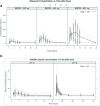A Phase Ib Study of the Dual PI3K/mTOR Inhibitor Dactolisib (BEZ235) Combined with Everolimus in Patients with Advanced Solid Malignancies
- PMID: 28357727
- PMCID: PMC5447332
- DOI: 10.1007/s11523-017-0482-9
A Phase Ib Study of the Dual PI3K/mTOR Inhibitor Dactolisib (BEZ235) Combined with Everolimus in Patients with Advanced Solid Malignancies
Abstract
Background: The combination of everolimus and the imidazoquinoline derivative, BEZ235 (dactolisib), a dual PI3K/mTOR inhibitor, demonstrated synergy in a preclinical model.
Objective: To establish clinical feasibility, a phase Ib dose-escalation trial investigating safety and pharmacokinetics of this combination in patients with advanced tumors was performed.
Patients and methods: BEZ235 was orally administered daily in escalating doses of 200, 400, and 800 mg along with everolimus at 2.5 mg daily in 28-day cycles. Nineteen patients were enrolled. Adverse events and tumor responses were evaluated using CTCAE v4.0 and RECIST 1.1, respectively. Pharmacokinetic analyses were performed.
Results: Common toxicities observed included fatigue, diarrhea, nausea, mucositis, and elevated liver enzymes. No confirmed responses were observed. BEZ235 pharmacokinetics exhibited dose-proportional increases in Cmax and AUC0-24 over the three doses, with high inter-individual variability. Non-compartmental and population pharmacokinetic-based simulations indicated significant increases in everolimus Cmax and AUC0-24 on day 28 and decreased clearance to 13.41 L/hr.
Conclusions: The combination of BEZ235 and everolimus demonstrated limited efficacy and tolerance. BEZ235 systemic exposure increased in a dose-proportional manner while oral bioavailability was quite low, which may be related to gastrointestinal-specific toxicity. The changes in steady-state pharmacokinetics of everolimus with BEZ235 highlight potential drug-drug interactions when these two drugs are administered together. Clinicaltrials.gov: NCT01508104.
Conflict of interest statement
Funding
The investigational agent, dactolisib (BEZ 235) used in this study, and funding for the pharmacokinetic analysis of patient samples was provided by Novartis Oncology (East Hanover, NJ, USA). Trisha Wise-Draper is supported by the clinical scientist training program at the University of Cincinnati (UC). Hala Elnakat Thomas is supported by a faculty pilot project grant by the Department of Internal Medicine at UC and a just-in-time award by the UC Cancer Center. We would also like to thank the Lcs Foundation for their support.
Conflict of Interest
Nagal Abdel Karim has received payment for lectures on everolimus for FDA-approved indications. Sara Kozma was an employee at the Friedrich Miescher Institute for Biomedical Research in Basel, Switzerland, which is affiliated with the Novartis Institute for Biomedical Research, from 1986 to 2003. George Thomas was employed as a scientific consultant by Novartis Oncology from 2000–2010. Olivier Rixe has received grants from Novartis through the University of Cincinnati to support the clinical trial and correlative studies. All other authors declare no conflicts of interest.
Figures



Similar articles
-
Phase 1/1b dose escalation and expansion study of BEZ235, a dual PI3K/mTOR inhibitor, in patients with advanced solid tumors including patients with advanced breast cancer.Cancer Chemother Pharmacol. 2018 Aug;82(2):285-298. doi: 10.1007/s00280-018-3610-z. Epub 2018 Jun 7. Cancer Chemother Pharmacol. 2018. PMID: 29882016 Free PMC article. Clinical Trial.
-
Phase II Study of BEZ235 versus Everolimus in Patients with Mammalian Target of Rapamycin Inhibitor-Naïve Advanced Pancreatic Neuroendocrine Tumors.Oncologist. 2018 Jul;23(7):766-e90. doi: 10.1634/theoncologist.2017-0144. Epub 2017 Dec 14. Oncologist. 2018. PMID: 29242283 Free PMC article. Clinical Trial.
-
A Phase II Study of BEZ235 in Patients with Everolimus-resistant, Advanced Pancreatic Neuroendocrine Tumours.Anticancer Res. 2016 Feb;36(2):713-9. Anticancer Res. 2016. PMID: 26851029 Free PMC article. Clinical Trial.
-
A phase 1 study of the sachet formulation of the oral dual PI3K/mTOR inhibitor BEZ235 given twice daily (BID) in patients with advanced solid tumors.Invest New Drugs. 2015 Apr;33(2):463-71. doi: 10.1007/s10637-015-0218-6. Epub 2015 Feb 25. Invest New Drugs. 2015. PMID: 25707361 Clinical Trial.
-
A Phase Ib Study of BEZ235, a Dual Inhibitor of Phosphatidylinositol 3-Kinase (PI3K) and Mammalian Target of Rapamycin (mTOR), in Patients With Advanced Renal Cell Carcinoma.Oncologist. 2016 Jul;21(7):787-8. doi: 10.1634/theoncologist.2016-0145. Epub 2016 Jun 10. Oncologist. 2016. PMID: 27286790 Free PMC article. Clinical Trial.
Cited by
-
iGMDR: Integrated Pharmacogenetic Resource Guide to Cancer Therapy and Research.Genomics Proteomics Bioinformatics. 2020 Apr;18(2):150-160. doi: 10.1016/j.gpb.2019.11.011. Epub 2020 Sep 8. Genomics Proteomics Bioinformatics. 2020. PMID: 32916316 Free PMC article.
-
Targeting RTK-PI3K-mTOR Axis in Gliomas: An Update.Int J Mol Sci. 2021 May 5;22(9):4899. doi: 10.3390/ijms22094899. Int J Mol Sci. 2021. PMID: 34063168 Free PMC article. Review.
-
Ponatinib, Lestaurtinib, and mTOR/PI3K Inhibitors Are Promising Repurposing Candidates against Entamoeba histolytica.Antimicrob Agents Chemother. 2022 Feb 15;66(2):e0120721. doi: 10.1128/AAC.01207-21. Epub 2021 Dec 6. Antimicrob Agents Chemother. 2022. PMID: 34871094 Free PMC article.
-
Therapeutic Potency of PI3K Pharmacological Inhibitors of Gastrointestinal Cancer.Middle East J Dig Dis. 2019 Jan;11(1):5-16. doi: 10.15171/mejdd.2018.122. Epub 2018 Nov 21. Middle East J Dig Dis. 2019. PMID: 31049177 Free PMC article. Review.
-
Induction of autophagy by PI3K/MTOR and PI3K/MTOR/BRD4 inhibitors suppresses HIV-1 replication.J Biol Chem. 2018 Apr 20;293(16):5808-5820. doi: 10.1074/jbc.RA118.002353. Epub 2018 Feb 23. J Biol Chem. 2018. PMID: 29475942 Free PMC article.
References
Publication types
MeSH terms
Substances
Associated data
LinkOut - more resources
Full Text Sources
Other Literature Sources
Medical
Miscellaneous

